Exclusive digital marketing services, 100% Satisfaction, and Money Back Guarantee! Learn More
The demand for full-stack developers continues to surge in 2025, driven by businesses seeking versatile tech talent that can bridge both front-end and back-end needs. But one of the most common questions aspiring developers ask is: How long does it take to become a full-stack developer? The answer isn’t one-size-fits-all. The timeline can vary significantly based on factors like prior experience, chosen learning path, and personal dedication. Whether you’re transitioning careers, learning part-time, or starting from scratch, your journey will look different.
What Does It Mean to Be a Full-Stack Developer?
A full-stack developer is someone who can handle both the client-facing (front-end) and server-side (back-end) components of a web application. From crafting responsive user interfaces to managing databases and APIs, this role requires a comprehensive understanding of how websites and applications function from top to bottom.
Key Skills and Responsibilities
To succeed, you must acquire both front-end and back-end skills. The full-stack developer learning roadmap often includes foundational knowledge like HTML, CSS, and JavaScript, followed by frameworks such as React for the front end and Node.js for the back end. Additional key areas include REST APIs, databases like MongoDB or PostgreSQL, and version control systems like Git.
- Mastering the front-end and back-end skills timeline requires persistence
- Hands-on experience for full-stack roles is critical for retention and job-readiness
Key Learning Paths and Their Timeframes
There are several ways to become a full-stack developer, and each comes with its own learning curve. Let’s explore the main routes:
Coding Bootcamps
Accelerated web development programs, such as bootcamps, are popular for their intensity and job-focused outcomes. A typical coding bootcamp duration ranges from 3 to 6 months, often requiring full-time commitment. These programs are structured to cover both front-end and back-end technologies quickly.
Self-Taught Learning
If you prefer flexibility, self-paced web development courses are widely available. However, this path requires strong discipline and consistent motivation. The beginner to job-ready full-stack timeline in a self-taught format can range from 6 to 18 months, depending on how much time you dedicate weekly.
Traditional Education & Degrees
A formal computer science degree remains a common path. However, a CS degree takes about 4 years to complete. While it provides a deeper understanding of software principles, it’s often less hands-on than other formats. Many students pair their degrees with web development certification time frames of a few months to become job-ready.
Factors That Influence Your Learning Timeline

Personal Commitment & Prior Knowledge
Your previous experience can greatly reduce how long it takes to become a full-stack developer. Designers transitioning to development, or those with basic coding knowledge, can often shorten the learning process. Ultimately, one of the biggest factors affecting full-stack learning time is your ability to consistently practice and learn.
Quality of Learning Resources
Using structured, up-to-date tutorials and guidance matters. A strong full-stack developer learning roadmap should include project-based learning, real-world application, and feedback loops. Quality resources speed up learning and deepen retention.
Recommended Learning Timeline Examples
Fast Track (3–6 Months)
Ideal for people undergoing a career change who can study full-time. These learners typically enroll in immersive bootcamps or commit to self-paced learning with structured goals. They also prioritize job-ready developer outcomes through portfolio projects.
Moderate Track (6–12 Months)
Best suited for complete beginners who balance other responsibilities. This pace allows for a deeper understanding while still working toward job placement in under a year. Many choose online part-time programs or structured self-study paths.
How to Speed Up the Process & Gain Real Experience
Hands-on experience for full-stack roles can dramatically increase your learning speed and confidence. Building portfolio projects, contributing to open-source code, and collaborating with peers are all effective strategies.
Platforms like GitHub allow you to share your code repositories and get feedback. Participating in agile development environments or real-time collaboration groups, like Discord servers, Slack communities, or local coding meetups, also builds real-world context.
Look for internships, freelance gigs, or custom website development services to apply your skills practically.
Conclusion
So, how long does it take to become a full-stack developer? It depends on your path, consistency, and how deeply you immerse yourself in practical learning. With dedication, many developers reach a job-ready state in less than a year.
Whether you’re self-taught, bootcamp-trained, or degree-certified, aligning your skills with professional website development services or contributing to custom website development services can help you turn your learning into career momentum.


